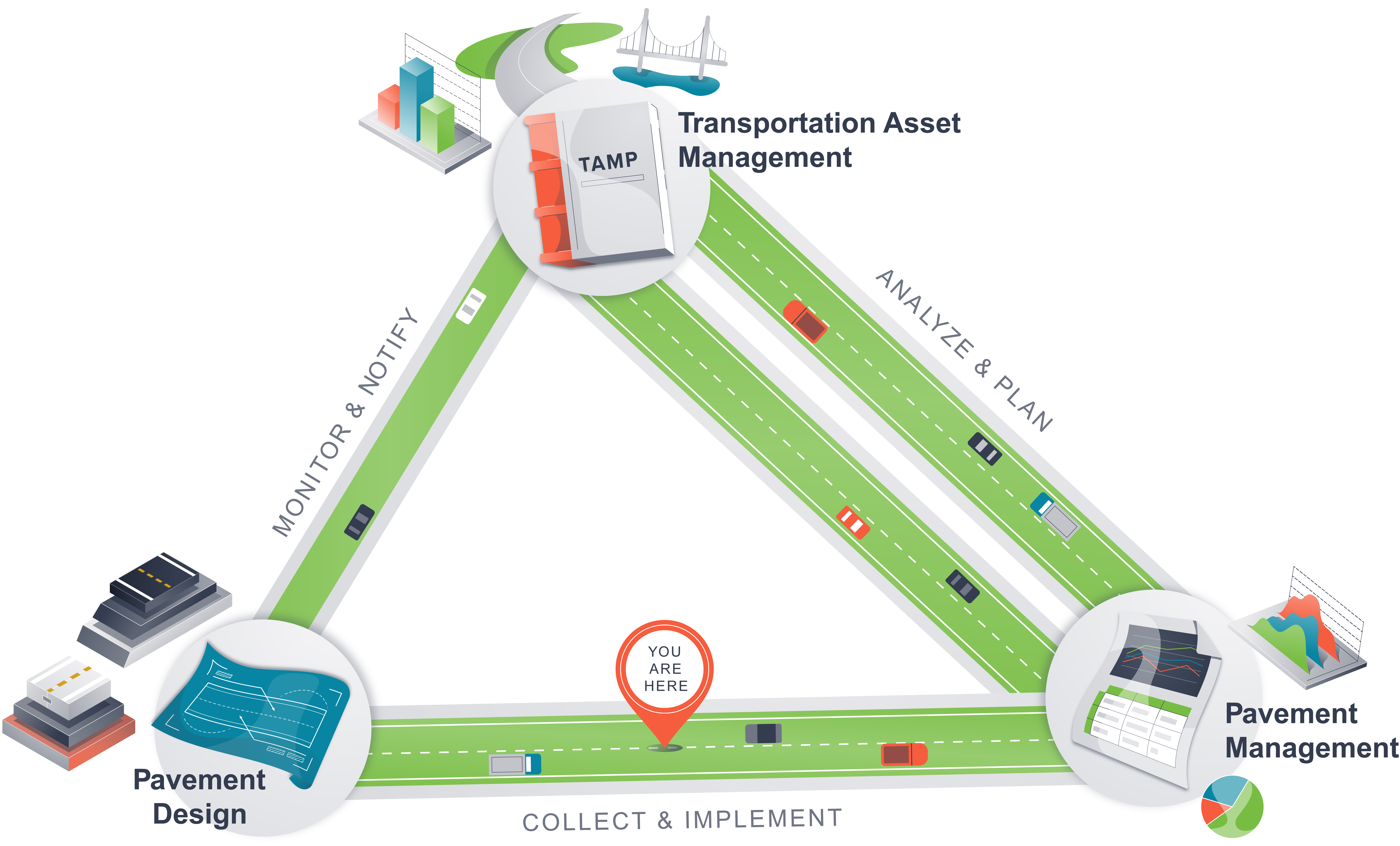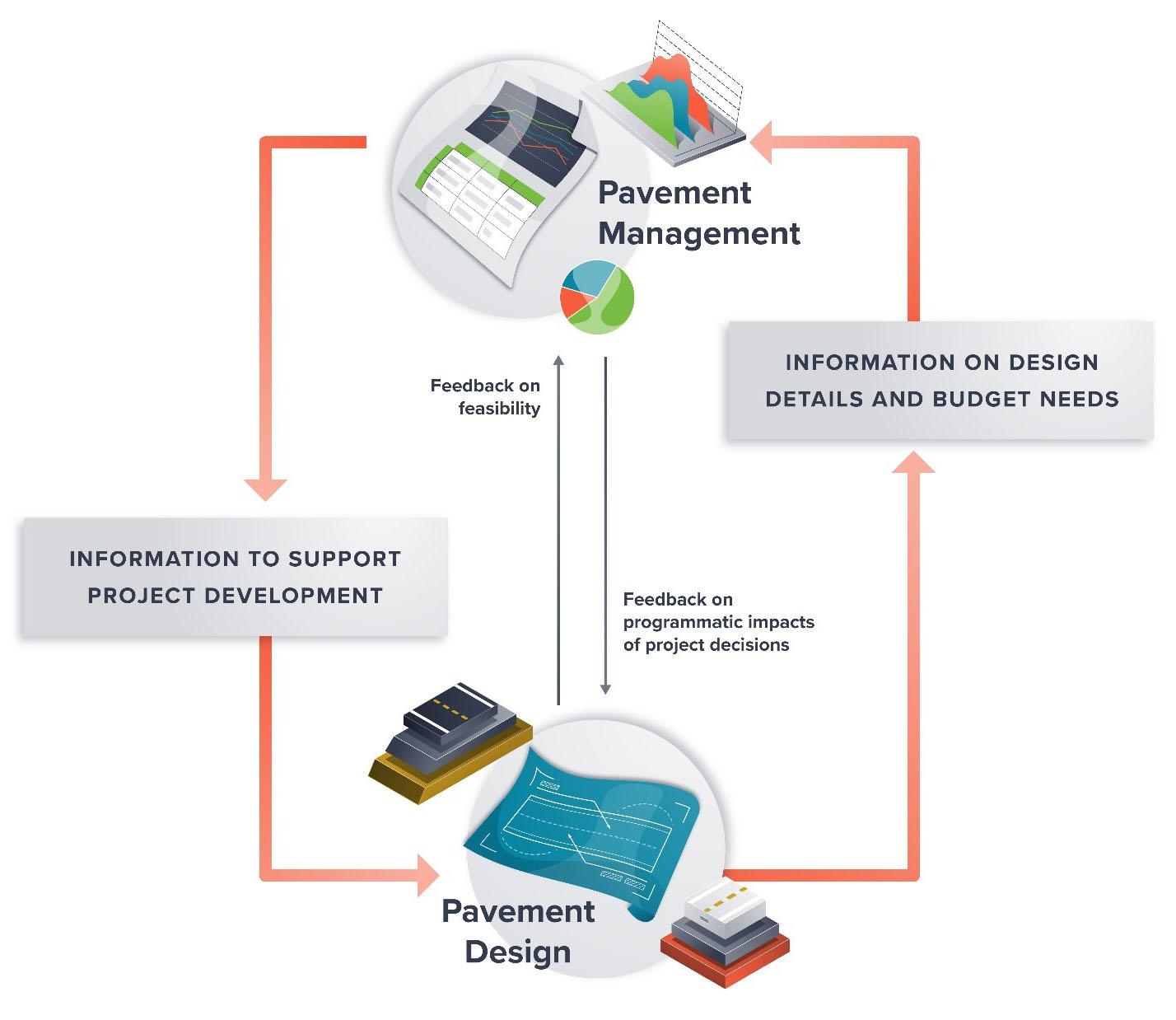Linking Pavement Design to Pavement Management

Pavement design, pavement management, and transportation asset management (TAM) are linked because each function relies on information provided by the other two. This webpage provides information on the links between pavement design and pavement management, including their importance; what data, systems, and organizational units support them; and how they can be strengthened. Pavement management is "a set of tools or methods that assist decision-makers in finding optimum strategies for providing, evaluating, and maintaining pavements in a serviceable condition over a period of time" (AASHTO 2012). TAM is "a strategic and systematic process of operating, maintaining, and improving physical assets, with a focus on both engineering and economic analysis based upon quality information, to identify a structured sequence of maintenance, preservation, repair, rehabilitation, and replacement actions to achieve and sustain a desired state of good repair (DSOGR) over the life cycle of assets at minimum practicable cost" (23 CFR 515.5). Pavement design is a project-level engineering effort based on detailed engineering and economic considerations meant to optimize pavement type and layer thicknesses to achieve project objectives at the lowest life cycle cost (23 CFR 626.2). The practice involves determining the material layers and thicknesses needed to support a defined traffic and climate criteria while maintaining an acceptable level of service for a given project.
In June 2021, State Department of Transportation (DOT) pavement design, pavement management, and asset management professionals participated in an Federal Highway Administration (FHWA) workshop that focused on identifying the links among these functions, processes, and organizational units. Participants recognized that pavement management typically involves network-level activities while pavement design is a project-level activity. Furthermore, participants noted that pavement management plays a key role in linking pavement design to asset management because pavement management involves the use of location-specific data and analysis to support network-level decisions. Pavement condition data is used by both pavement design and pavement management units. Pavement management data and analyses are used to select projects and establish project scopes. Project-specific pavement design data may be used to improve pavement management forecasts and validate deterioration models. Additionally, preferred pavement life-cycle strategies are represented in the analysis inputs to both pavement management (e.g., treatment definitions and decision trees) and pavement design (e.g., end of life conditions and future treatment needs and timings).
The link between pavement design and pavement management could be strengthened by activities such as:
- Pavement management providing multi-year project recommendations including detailed types of treatments recommended for each project.
- Using pavement management forecasts to provide long-term plans for each pavement section, helping designers understand how the scope of their projects support long-term strategies.
- Using detailed pavement design and construction data as inputs to the pavement management system (PMS) to improve the precision and accuracy of pavement management forecasts.
- Aligning the performance models used for pavement management and establishing predicted distresses for pavement design criteria.
 Policy and Procedural Links Between Pavement Design and Pavement Management
Policy and Procedural Links Between Pavement Design and Pavement Management
Aligning Pavement Management Strategies with Pavement Design
Long-term pavement life cycle and investment strategies are developed using a pavement management system (PMS) and by analyzing different scenarios and comparing the costs and benefits of each. The preferred investment strategy can then be used to support the project selection process by recommending initial project scopes and supporting initial cost estimates. After a project is selected and design is initiated, the pavement design process is critical to finalizing project scopes. Since the PMS is used to recommend or validate a significant portion of those project scopes, it is important that the pavement design and pavement management processes are aligned. Inputs to pavement management analysis and pavement design do not need to be identical and will most likely vary. For instance, pavement management will often use fewer condition metrics and may use composite condition indices for decision support, while pavement design will use a wider range of condition measures that are more location specific. One way to align these inputs is to compare similar thresholds used in pavement design and pavement management analyses, such as:
- Do the conditions that represent failure criteria in pavement design also trigger a rehabilitation or reconstruction in the PMS?
- Are the deterioration curves used in PMS reflective of the design lives of newer pavements?
- Are there pavement attributes that limit the use of some treatments (e.g., the presence of curb ramps or closed drainage inlets) that are not captured in PMS?
- Are the assumed treatment needs and timings for long-term strategies consistent between the two processes?
- Are the unit costs consistent between the PMS and the pavement design inputs?
- How does the alignment between pavement design and pavement management criteria vary by pavement type?
To keep the inputs aligned, coordination may be needed between staff responsible for the upkeep of the PMS and those responsible for the development of the pavement design standards and the associated tools. As new treatments, construction methods, materials, and data sources are introduced, both pavement design and pavement management standards and tools may need coordination updates.
Utah DOT: A Plan for Every Section
For each road segment, the Utah Department of Transportation (DOT) engineers develop a pavement preservation plan that considers road type, traffic conditions, and expected roadway life. As work is performed on the system, each surface maintenance treatment is tracked and the next optimal treatment is planned. Applying the right treatment at the right time prevents more serious deterioration and extends service life. A seriously deteriorated road will need costly major rehabilitation or full reconstruction sooner than anticipated.
Project Selection, Scoping, and Budget Setting
Pavement management analysis results are used to support the identification and selection of projects that address pavement needs and support long term life-cycle plans or investment strategies. Various units within a DOT are also involved in the delivery of a pavement program to meet both regulatory and statutory requirements, as well as to provide efficient project delivery. Projects recommended fr om multiple program areas (e.g., pavement management, bridge management, and safety management) are compared and prioritized to select projects for funding. Once selected, projects are allocated funding through programs such as the Statewide Transportation Improvement Program (STIP). From this point, projects move from programming to delivery (i.e., design and construction).
Participants in a recent FHWA workshop noted that the link between pavement management and pavement design was often not strong enough in coordinating between management of overall condition objectives and specific project objectives. Traditional project development practices advance a project through the phases of planning, scoping, design, and construction and involves transfer of responsibility between offices at key project-development milestones. Although this approach provides a clear decision-making role, it may not consider how the additional information gathered in design can lead to scope and cost changes. Increases in project scope can draw resources from other network needs whereas decreases in project scope may lead to the project not addressing the original planning-level need as intended.
By tracking project-level scope and budget changes, agencies can determine if those changes will have program level impacts.
For example, many DOTs have begun to implement processes that include a project manager who shepherds a project from scoping through construction. This improves continuity in knowledge and decision making as the project develops. In most cases, the decision-making authority is still passed between units at the key selection, scoping, design, and construction milestones.
Another approach to align program and project level needs is to implement periodic design reviews. This provides opportunities to review changes in project scopes and budgets and determines impacts to the achievement of programatic objectives. An example of this approach is New Jersey DOT's (NJDOT) review process for pavement preservation projects. In NJDOT pavement preservation projects, this check point is triggered based on a specific time period (2 years). Additionally, reviews could occur at specific project milestones such as preliminary engineering reviews of scoping or potential design alternatives.
 Organizational Links between Pavement Design and Pavement Management
Organizational Links between Pavement Design and Pavement Management
An approach to organizationally link pavement design to broader program requirements is to establish a single organizational unit that houses both pavement management and pavement design functions. Several State DOTs, including NJDOT as highlighted in the case study below, have implemented such units.
New Jersey DOT 2-year Pavement Preservation Review Process
New Jersey DOT's pavement management unit proposes candidate pavement preservation project locations that are advanced through design and construction after detailed pavement design evaluation. Evaluations provide confirmation as to whether a project is appropriate for preservation and contains treatment recommendations. As a project moves to project design, other factors such as safety, mobility, and environmental impacts are considered to determine the needed project scope. Typically, projects will advance through design quickly if a preservation treatment is appropriate after review of all design considerations. However, there are times when data gathered for design lead to a scope change to rehabilitation, realignment, or reconstruction of the pavement. Because of this, NJDOT has implemented a 2-year review of pavement projects in the design process to determine if the current design still qualifies as a pavement preservation project. If it does not, the project is pulled from the preservation program and moved to the broader rehabilitation and construction program to compete for funding again under similar projects.
Housing the pavement management and design functions in a single unit also supports the alignment of the data, criteria, and systems used for these two functions. Both the functions and the software tools that support them rely on pavement inventory and condition data. However, each function may manipulate the root condition data in different ways to calculate different measures or indices. While each has specific needs, it is important that these functions work from a common data set that is aligned geospatially and based on the same linear referencing system. Alignment of the data can ensure pavement management recommendations and pavement designs are addressing the same locations
This organizational alignment can also support cross training of staff on network and project-level analyses and tools. As staff become familiar with both pavement management and design tools, they can identify opportunities for improvement in data or processes.
Implementing a combined pavement management and pavement design unit is typically done by agencies where pavement design is performed by a single organizational unit within the agency, i.e., a centralized pavement design unit. Combining pavement management and pavement design is typically done when one or both functions is distributed across multiple units, e.g., when district offices conduct pavement design for their respective projects.
A disadvantage of this approach is that a combined pavement management and design unit is typically located in an engineering office and may not be closely tied to long-term or strategic planning activities. Agencies can overcome this disadvantage by instituting some aspects of a cross-functional pavement team. A cross-functional pavement team is a group of staff from multiple organizational units that is given decision-making authority over some aspects of pavement management and pavement design. This approach can provide alignment across the organization without formal changes to reporting structure. Furthermore, cross-functional teams can be established quickly and can easily adjust to changes in staffing, objectives, or internal controls. Finally, cross-functional teams provide a mechanism for coordinated decision-making in agencies with decentralized authority.
Regardless of the organizational approach taken, agencies can establish and document processes for collaboration between technical staff to vet changes in items used in planning, programming, and design decisions. This includes decision criteria, software configurations, performance metrics, and data standards, among others. The vetting process should include other agency staff who either provide information to the decision-making process in question or staff whose work is downstream from the decisions to be made through the process. This type of vetting process can be formal or informal to meet the agency's needs, but either approach may provide a crucial feedback loop to help link project, programming, and planning decisions.
 Links Between Pavement Design, Pavement Management Systems, and Data
Links Between Pavement Design, Pavement Management Systems, and Data
Traditionally, each PMS and form of pavement design software managed and stored separate datasets for their respective analyses. Until recently, much of the data collected by State DOTs for pavement design, such as pavement core analysis and soils reports, was stored in hard-copy reports and files. Since data was not shared between software applications, it was not possible for either system to utilize information from the other. The following two advancements in technology are being adopted by agencies to help align data between pavement management and design:
Learn more about organizing data to link pavement design, pavement management, and TAM.
Network Collection of Pavement Structure Data
Several State DOTs collect network-level structural evaluation of the pavement either through testing with falling weight deflectometers (FWD) or traffic speed deflection devices (TSDD). This approach can support pavement management as well as pavement design. The routine network collection of these data improves the amount and quality of information provided to both processes. Since the structure of a pavement can vary depending on environmental factors, such as soil moisture content and ground temperature, it is important that structural data be collected multiple times per location to establish a full picture of pavement condition for pavement design.
By collecting structural data on a regular cycle, agencies can also build sufficient data history to develop deterioration models and treatment thresholds to support pavement management. This inclusion of structural data in network-level pavement management analysis is becoming important guidance in the use of preservation treatments. These treatments can extend pavement life by addressing certain kinds of surface distresses but are not effective in correcting structural deficiencies.
Digitization of Engineering Reports
Other key sources of network-level data collected through project-level efforts include records from design investigations and construction quality assurance test results. Both data streams are collected as projects and are both developed and delivered. As the data set is built out project by project over time, this can provide nearly full-network coverage. In the past, design investigations have been saved in design reports and construction acceptance records have been saved in a variety of project records. Starting in the 1990s, agencies began turning these records into electronic documents. This made the records more accessible, but still not useful for large-scale analysis.
Agencies are currently migrating these data collection processes to input test and inspection results directly into data sets that are linked to geographic locations. This is creating rich data sets of site and pavement characteristics that can be useful to both pavement design and management in the future. Additionally, advances in artificial intelligence (AI) are leading to the ability to scan older electronic documents to extract data into these structured data sets.
The following graphic lists many of the specific direct links that pavement management and pavement design share. The links are presented in terms of the data and information that may need to be transmitted between areas and the types of feedback that may be needed to improve pavement-related policies, processes, and procedures. Feedback is then provided from the receiving unit as to the accuracy, timeliness, and relevance of the provided data.
As described above, pavement management and pavement design are linked through numerous processes, each of which involves information and data being sent from one group to the other. For each process, information flows from one unit to another in support of achieving a business need of the agency, such as identifying pavement projects or producing pavement design recommendations. Typically, agencies’ documented procedures for these processes describe the information that is passed from the unit which creates the information to the unit which recieves it. These types of procedures do not always account for feedback from the recipient to the provider, but providing regular feedback is critical to strengthening the link between pavement management and pavement design. The following graphic shows examples of information that can be passed between these two units in support of processes decribed above. The thick lines in the graphic show the primary flow of informaton in support of each process, while the thin lines show the flow of feedback.
Typical Transmittals from Pavement Management to Pavement Design
- Project scope:
- Location
- Length/limits
- Road functional class
- Existing pavement type
- Recommended treatment category and treatment type
- Logic behind recommended treatment type, e.g.,
- Why was the treatment triggered?
- What was the calculated value and cost?
- What was the calculated value and cost of higher and lower potential treatment types?
- Project budget or anticipated costs
- Inventory
- Pavement history
- Traffic history
- Condition history and performance trends
Potential Feedback from Pavement Design
- Appropriateness of recommended treatment type (existing condition, traffic, construction, or performance issues)
- Related projects in area
- Completeness of history
- Sufficient resolution of condition/performance data (segmentation)
- Usefulness of condition/performance metrics
- Reasonableness of proposed project costs

Typical Transmittals from Pavement Design to Pavement Management
- Proposed or final pavement design
- Design analysis outputs (predicted performance) Strategy selection outputs (strategy options, life cycle costs)
Potential Feedback Pavement Management
- Differences in design-predicted performance and PMS-predicted performance
- Reasons for deviation from recommended treatment type
- Differences in design-predicted performance and PMS-measured (actual) performance
- Reasons for differences in performance (e.g., performance measures and criteria, deterioration models, site-specific factors) Impacts on changes in project scope or budget on predicted system performance
REFERENCES
American Association of State Highway and Transportation Officials (AASHTO). 2012. Pavement Management Guide, Second Edition 2012. AASHTO, Washington, DC.
California Department of Transportation (Caltrans). 2021. State Highway System Management Plan – Draft. California Department of Transportation. Sacramento, CA.
National Academies of Sciences, Engineering, and Medicine. 2018. Staffing for Alternative Contracting Methods. Washington, DC: The National Academies Press. https://doi.org/10.17226/25211. New York State Department of Transportation (NYSDOT). 2019. Transportation Asset Management Plan. NYSDOT. Albany, NY.

